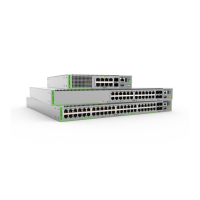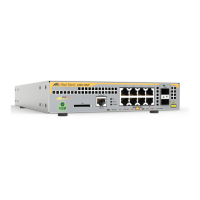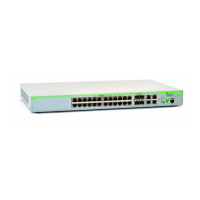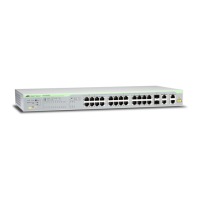GS980MX Series Installation Guide for Virtual Chassis Stacking
73
Stack Trunks of 5Gbps Ports On the GS980MX/10HSm, GS980MX/
18HSm, GS980MX/28PSm, or GS980MX/52PSm
The 10Gbps SFP+ ports are not the only ports you can use for a trunk of a
stack. If you prefer to use the 10Gbps ports for other functions, you can
use the 5Gbps ports for the trunk instead. On the GS980MX/10HSm,
GS980MX/18HSm, GS980MX/28PSm, or GS980MX/52PSm you can use
two, three or all four multi-speed twisted pair 5Gbps ports per switch for a
trunk. As with a trunk based on 10Gbps SFP+ ports, the more 5Gbps ports
a trunk has, the greater its bandwidth and resiliency.
The rules and guidelines for a stack trunk of 5Gbps ports are similar to
stack trunks of 10Gbps ports.
Stacks can have up to four switches.
For 5Gbps stacking ports, you can choose between these twisted
pair ports.
– GS980MX/10HSm: 1 to 8
– GS980MX/18HSm: 1 to 16
– GS980MX/28PSm: 21 to 24
– GS980MX/52PSm: 41 to 44 and 45 to 48
The trunk can have from two or all 5Gbps ports per switch.
When possible, you should use the same ports on all the switches
of a stack. This is not a requirement, but it can make managing and
troubleshooting a stack easier. For example, you might designate
ports 5 and 6 on a stack of GS980MX/10HSm switch to be the
stacking ports.
You designate the stack ports with the STACKPORT command.
Once ports are designated as trunk ports, you cannot view of
change their parameter settings.

